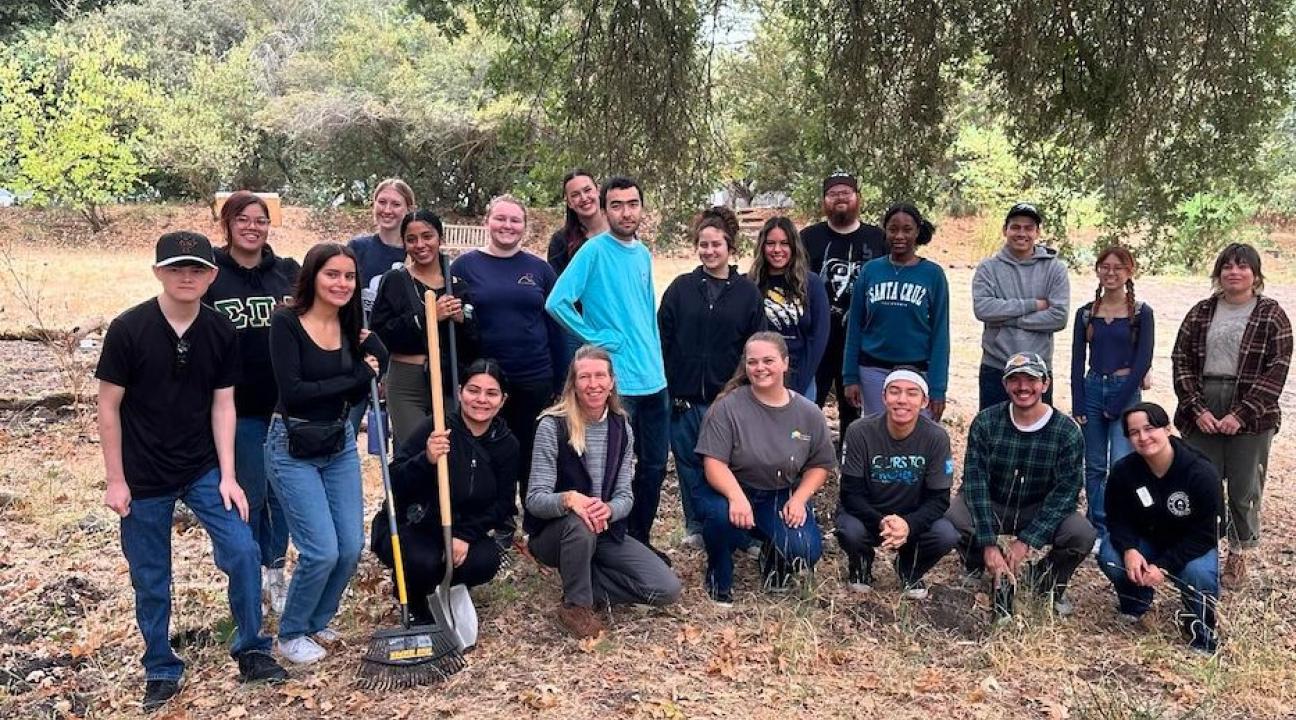Sonoma State researchers add to wildfire prediction, mitigation, and resilience
As the number of extreme wildfires has doubled globally in the past two decades, California has not been immune from the trend. The state is at the top of the list for fire danger in the United States, with an average of almost 960,000 acres burned each year
Sonoma State's grant-based research on wildfire mitigation and prediction is integral for local fire-threatened communities and has implications for wildfire management worldwide.
Funded through NASA, the National Science Foundation, and Cal Fire, among others, studies by SSU faculty, students, and staff are keying in on the connection between vegetation and wildfire.
"I wasn't focused on fire before the Tubbs Fire. It changed my whole research agenda," said Mathew Clark, SSU professor and Director of the Center for Interdisciplinary Geospatial Analysis (CIGA).
Thanks to funding through NASA and Cal Fire, Clark’s research project provides continuous data across California for pre-fire and post-fire measurements and long-term monitoring of forest regrowth and fuels treatments.
"California is an interesting place to study fire behavior because there have been so many large fires within the recent past," he said.
Clark uses NASA's Global Ecosystem Dynamics Investigation (GEDI) system – which uses an International Space Station-mounted laser to measure the vertical distribution of leaves and branches in forests or other vegetation. It has collected data globally since 2019 and provides information on forest structure and biomass that can feed large hazardous fires.
"It helps us see what fuels exist, especially in the lower canopy. This information is important because when a surface fire spreads to the canopy, it can cause a more severe fire," he said.
"This is a vital research domain, and there is still much to learn,” Clark continued. “Using technology to monitor our forests better and more effectively will help us detect change, but most importantly, it will give us tools to strategize what to do with fire fuels that have built up in our forests and prevent large, high severity fires in the future."
SSU Associate Professor of Biology Dr. Lisa Patrick Bentley has been conducting similar analysis with her team of student researchers.
"Our studies are motivated by emerging needs to manage fire fuels and timber, to improve carbon accounting, and ultimately to aid in wildfire prediction," Bentley said.
Bentley and her team combine remote sensing (LiDAR scanning) with traditional forestry approaches to collect detailed information about forest structure. They are studying the effects of wildfire and fuel management on forested ecosystems in California in the context of a changing climate.
"My research team is one of the few groups worldwide using terrestrial laser scanning (TLS) to examine how forest structure, such as the connectivity of fuels or regrowth of trees, changes following disturbances like a wildfire," Bentley said.
Bentley said graduate and undergraduate students often help develop innovative approaches to advance the field of remote sensing of 3D forest structure.
Randi Carter, a master of science candidate at SSU is collaborating with Bentley Lab technician Elliott Smeds to apply a mathematical metric of LiDAR data to quantify changes in the structural complexity of forests after wildfire and fuels management.
Bentley said the team “hopes the metric will relate to wildfire intensity and have the potential to help predict wildfire risk in forested areas with variable fuel loads.”
Bentley uses her research data in classes related to plants, ecology, and climate change.
"I'm excited about integrating research with education in novel ways, such as virtual reality, to increase scientific literacy and public engagement around wildfire," she said.
Land Management and Community Engagement
SSU Center for Environmental Inquiry (CEI) Director Dr. Claudia Luke has been awarded five grants to engage faculty and students in various fire-related aspects of land management at SSU’s three preserves – Galbreath, Osborn, and Los Guillicos. Projects have included prescribed burning, forestry management, fuel reduction, and fire safety.
"SSU preserves provide such a huge learning opportunity," Luke said, citing the fuel reduction project at SSU’s Osborn Preserve as one example.
Preserve grasslands have not been grazed for over 50 years, resulting in a buildup of dead grass – thatch – and the spread of invasive species.
Cali Pearce, CEI’s new preserve manager, and Mitch Neve, a neighboring cattle rancher, are developing a grazing approach at Osborn that improves fire safety and protects native species.
“Cattle trampling is great for reducing thatch and improving fire safety,” said Pearce, who oversees the project. “And luckily cattle can even be coerced into eating invasive species.”
The project will become a demonstration and training site for better understanding of the benefits and tradeoffs of fuel reduction.
Pearce said in winter SSU students in CEI’s Land Management Training Program will get involved in monitoring and grazing prescriptions and begin leading tours for the public.
The project is being done in collaboration with Sonoma County Regional Parks, Gold Ridge Resource Conservation District, California Coastal Conservancy, and UC Cooperative Extension.
Krista Sherer - Strategic Communications Writer
The content of this article is solely the responsibility of the authors and does not necessarily represent the official views of the funders.
Research reported in this article is supported by collective funding from the following awards.
Matthew Clark:
-
National Aeronautics and Space Administration, Award #80NSSC23K1459 $99,196
-
Cal Fire, Award #8GG21820, $492,779
Lisa Bentley:
-
Cal Poly Corporation/California State University Agricultural Research Institute, Award #2022-9-58867, $49,618.00
-
National Science Foundation CAREER Award, Award #2145728, $1,100,215
-
National Aeronautics and Space Administration, Award #80NSSC22K1266, $29,362
-
Department of Forestry and Fire Protection (CALFIRE), Award #8GG21800, $78,474
-
Cal Fire, Award #8GG21803, $74,141
-
U.S. Department of Interior, Bureau of Land Management. Award #L24AC00279-00, $24,097
Claudia Luke:
-
Sonoma Ecology Center Wildfire Resilience Program, AGREEMENT 7.11.23, $210,100
-
Cal Poly Humboldt Sponsored Programs Foundation/California Department of Forestry and Fire Protection (CALFIRE), Award #0007102728, $241,464 Mendocino County Fire Safe Council, Award #AP 7.19.2023, $7,535
-
Gold Ridge Resource Conservation District, Landsmart Program, $80,000







